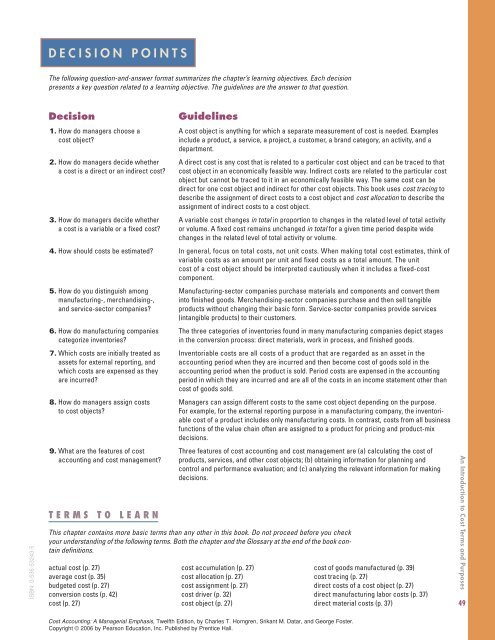2 an introduction to cost terms and purposes - Pearson Learning ...
2 an introduction to cost terms and purposes - Pearson Learning ...
2 an introduction to cost terms and purposes - Pearson Learning ...
You also want an ePaper? Increase the reach of your titles
YUMPU automatically turns print PDFs into web optimized ePapers that Google loves.
DECISION POINTS<br />
The following question-<strong>an</strong>d-<strong>an</strong>swer format summarizes the chapter’s learning objectives. Each decision<br />
presents a key question related <strong>to</strong> a learning objective. The guidelines are the <strong>an</strong>swer <strong>to</strong> that question.<br />
ISBN: 0-536-53243-5<br />
Decision<br />
Guidelines<br />
1. How do m<strong>an</strong>agers choose a A <strong>cost</strong> object is <strong>an</strong>ything for which a separate measurement of <strong>cost</strong> is needed. Examples<br />
<strong>cost</strong> object?<br />
include a product, a service, a project, a cus<strong>to</strong>mer, a br<strong>an</strong>d category, <strong>an</strong> activity, <strong>an</strong>d a<br />
department.<br />
2. How do m<strong>an</strong>agers decide whether A direct <strong>cost</strong> is <strong>an</strong>y <strong>cost</strong> that is related <strong>to</strong> a particular <strong>cost</strong> object <strong>an</strong>d c<strong>an</strong> be traced <strong>to</strong> that<br />
a <strong>cost</strong> is a direct or <strong>an</strong> indirect <strong>cost</strong>? <strong>cost</strong> object in <strong>an</strong> economically feasible way. Indirect <strong>cost</strong>s are related <strong>to</strong> the particular <strong>cost</strong><br />
object but c<strong>an</strong>not be traced <strong>to</strong> it in <strong>an</strong> economically feasible way. The same <strong>cost</strong> c<strong>an</strong> be<br />
direct for one <strong>cost</strong> object <strong>an</strong>d indirect for other <strong>cost</strong> objects. This book uses <strong>cost</strong> tracing <strong>to</strong><br />
describe the assignment of direct <strong>cost</strong>s <strong>to</strong> a <strong>cost</strong> object <strong>an</strong>d <strong>cost</strong> allocation <strong>to</strong> describe the<br />
assignment of indirect <strong>cost</strong>s <strong>to</strong> a <strong>cost</strong> object.<br />
3. How do m<strong>an</strong>agers decide whether A variable <strong>cost</strong> ch<strong>an</strong>ges in <strong>to</strong>tal in proportion <strong>to</strong> ch<strong>an</strong>ges in the related level of <strong>to</strong>tal activity<br />
a <strong>cost</strong> is a variable or a fixed <strong>cost</strong>? or volume. A fixed <strong>cost</strong> remains unch<strong>an</strong>ged in <strong>to</strong>tal for a given time period despite wide<br />
ch<strong>an</strong>ges in the related level of <strong>to</strong>tal activity or volume.<br />
4. How should <strong>cost</strong>s be estimated? In general, focus on <strong>to</strong>tal <strong>cost</strong>s, not unit <strong>cost</strong>s. When making <strong>to</strong>tal <strong>cost</strong> estimates, think of<br />
variable <strong>cost</strong>s as <strong>an</strong> amount per unit <strong>an</strong>d fixed <strong>cost</strong>s as a <strong>to</strong>tal amount. The unit<br />
<strong>cost</strong> of a <strong>cost</strong> object should be interpreted cautiously when it includes a fixed-<strong>cost</strong><br />
component.<br />
5. How do you distinguish among M<strong>an</strong>ufacturing-sec<strong>to</strong>r comp<strong>an</strong>ies purchase materials <strong>an</strong>d components <strong>an</strong>d convert them<br />
m<strong>an</strong>ufacturing-, merch<strong>an</strong>dising-, in<strong>to</strong> finished goods. Merch<strong>an</strong>dising-sec<strong>to</strong>r comp<strong>an</strong>ies purchase <strong>an</strong>d then sell t<strong>an</strong>gible<br />
<strong>an</strong>d service-sec<strong>to</strong>r comp<strong>an</strong>ies? products without ch<strong>an</strong>ging their basic form. Service-sec<strong>to</strong>r comp<strong>an</strong>ies provide services<br />
(int<strong>an</strong>gible products) <strong>to</strong> their cus<strong>to</strong>mers.<br />
6. How do m<strong>an</strong>ufacturing comp<strong>an</strong>ies The three categories of inven<strong>to</strong>ries found in m<strong>an</strong>y m<strong>an</strong>ufacturing comp<strong>an</strong>ies depict stages<br />
categorize inven<strong>to</strong>ries?<br />
in the conversion process: direct materials, work in process, <strong>an</strong>d finished goods.<br />
7. Which <strong>cost</strong>s are initially treated as Inven<strong>to</strong>riable <strong>cost</strong>s are all <strong>cost</strong>s of a product that are regarded as <strong>an</strong> asset in the<br />
assets for external reporting, <strong>an</strong>d accounting period when they are incurred <strong>an</strong>d then become <strong>cost</strong> of goods sold in the<br />
which <strong>cost</strong>s are expensed as they accounting period when the product is sold. Period <strong>cost</strong>s are expensed in the accounting<br />
are incurred?<br />
period in which they are incurred <strong>an</strong>d are all of the <strong>cost</strong>s in <strong>an</strong> income statement other th<strong>an</strong><br />
<strong>cost</strong> of goods sold.<br />
8. How do m<strong>an</strong>agers assign <strong>cost</strong>s M<strong>an</strong>agers c<strong>an</strong> assign different <strong>cost</strong>s <strong>to</strong> the same <strong>cost</strong> object depending on the purpose.<br />
<strong>to</strong> <strong>cost</strong> objects?<br />
For example, for the external reporting purpose in a m<strong>an</strong>ufacturing comp<strong>an</strong>y, the inven<strong>to</strong>riable<br />
<strong>cost</strong> of a product includes only m<strong>an</strong>ufacturing <strong>cost</strong>s. In contrast, <strong>cost</strong>s from all business<br />
functions of the value chain often are assigned <strong>to</strong> a product for pricing <strong>an</strong>d product-mix<br />
decisions.<br />
9. What are the features of <strong>cost</strong> Three features of <strong>cost</strong> accounting <strong>an</strong>d <strong>cost</strong> m<strong>an</strong>agement are (a) calculating the <strong>cost</strong> of<br />
accounting <strong>an</strong>d <strong>cost</strong> m<strong>an</strong>agement? products, services, <strong>an</strong>d other <strong>cost</strong> objects; (b) obtaining information for pl<strong>an</strong>ning <strong>an</strong>d<br />
control <strong>an</strong>d perform<strong>an</strong>ce evaluation; <strong>an</strong>d (c) <strong>an</strong>alyzing the relev<strong>an</strong>t information for making<br />
decisions.<br />
TERMS TO LEARN<br />
This chapter contains more basic <strong>terms</strong> th<strong>an</strong> <strong>an</strong>y other in this book. Do not proceed before you check<br />
your underst<strong>an</strong>ding of the following <strong>terms</strong>. Both the chapter <strong>an</strong>d the Glossary at the end of the book contain<br />
definitions.<br />
actual <strong>cost</strong> (p. 27)<br />
average <strong>cost</strong> (p. 35)<br />
budgeted <strong>cost</strong> (p. 27)<br />
conversion <strong>cost</strong>s (p. 42)<br />
<strong>cost</strong> (p. 27)<br />
<strong>cost</strong> accumulation (p. 27)<br />
<strong>cost</strong> allocation (p. 27)<br />
<strong>cost</strong> assignment (p. 27)<br />
<strong>cost</strong> driver (p. 32)<br />
<strong>cost</strong> object (p. 27)<br />
<strong>cost</strong> of goods m<strong>an</strong>ufactured (p. 39)<br />
<strong>cost</strong> tracing (p. 27)<br />
direct <strong>cost</strong>s of a <strong>cost</strong> object (p. 27)<br />
direct m<strong>an</strong>ufacturing labor <strong>cost</strong>s (p. 37)<br />
direct material <strong>cost</strong>s (p. 37)<br />
An Introduction <strong>to</strong> Cost Terms <strong>an</strong>d Purposes<br />
49<br />
Cost Accounting: A M<strong>an</strong>agerial Emphasis, Twelfth Edition, by Charles T. Horngren, Srik<strong>an</strong>t M. Datar, <strong>an</strong>d George Foster.<br />
Copyright © 2006 by <strong>Pearson</strong> Education, Inc. Published by Prentice Hall.

















